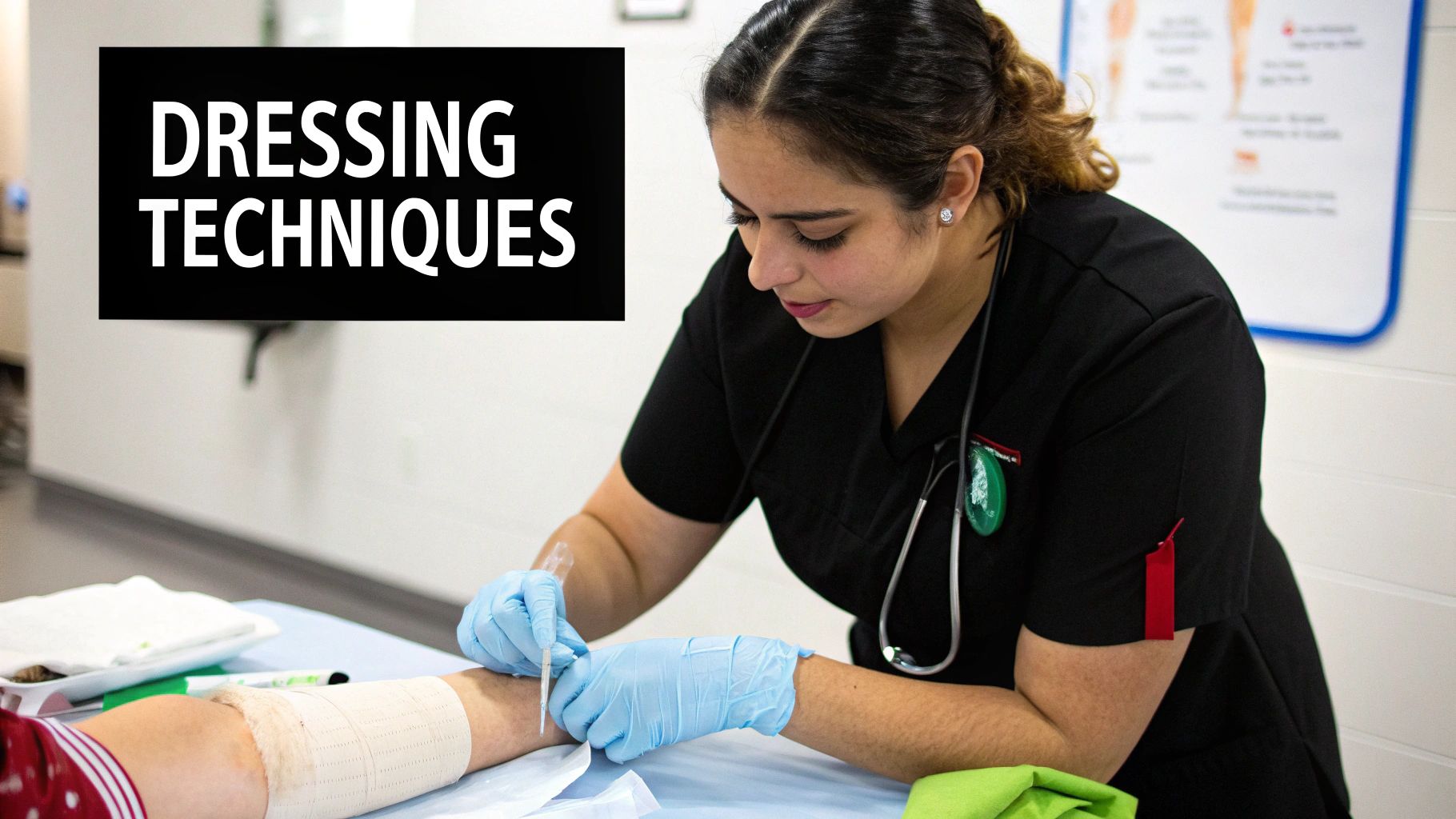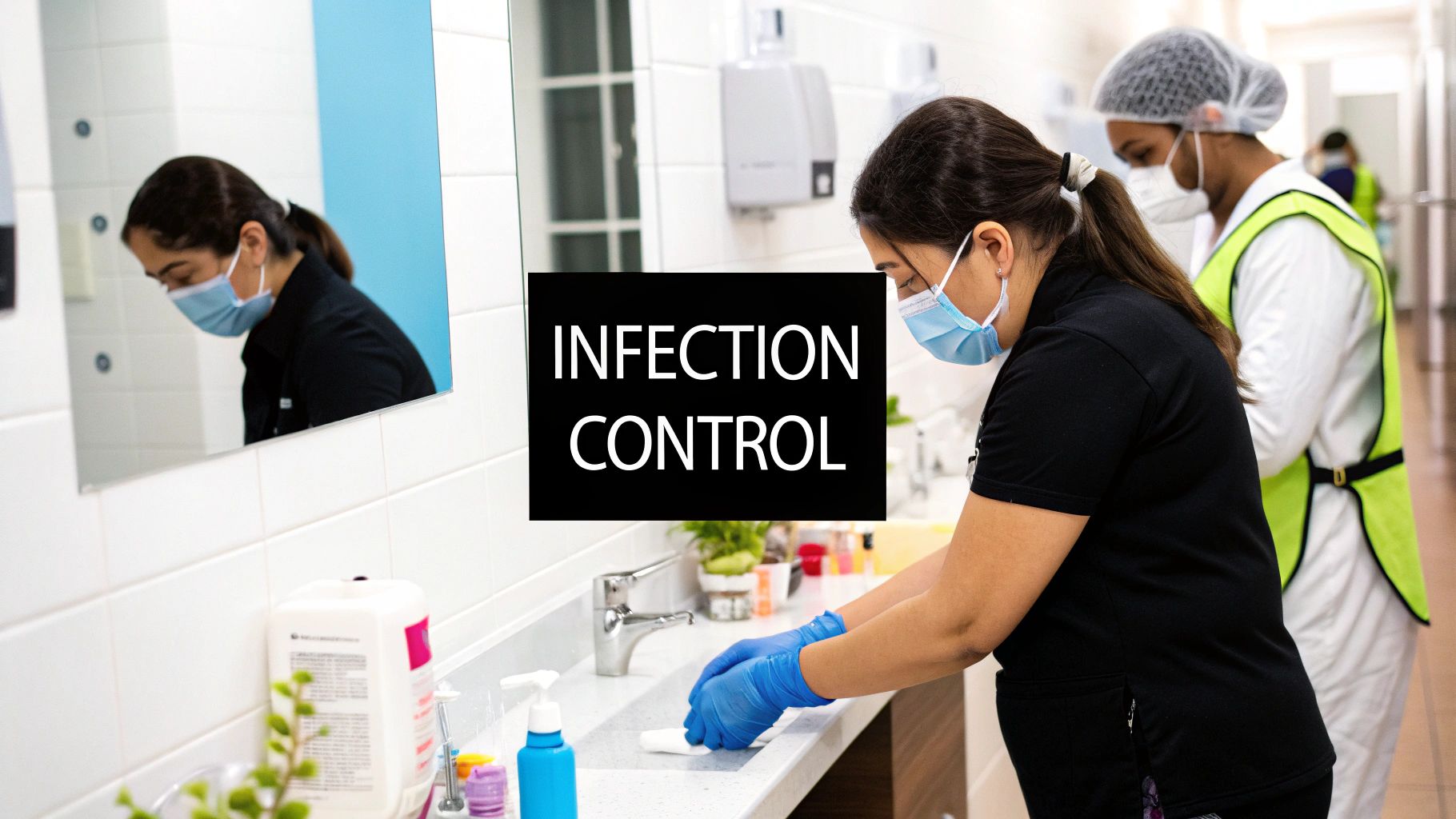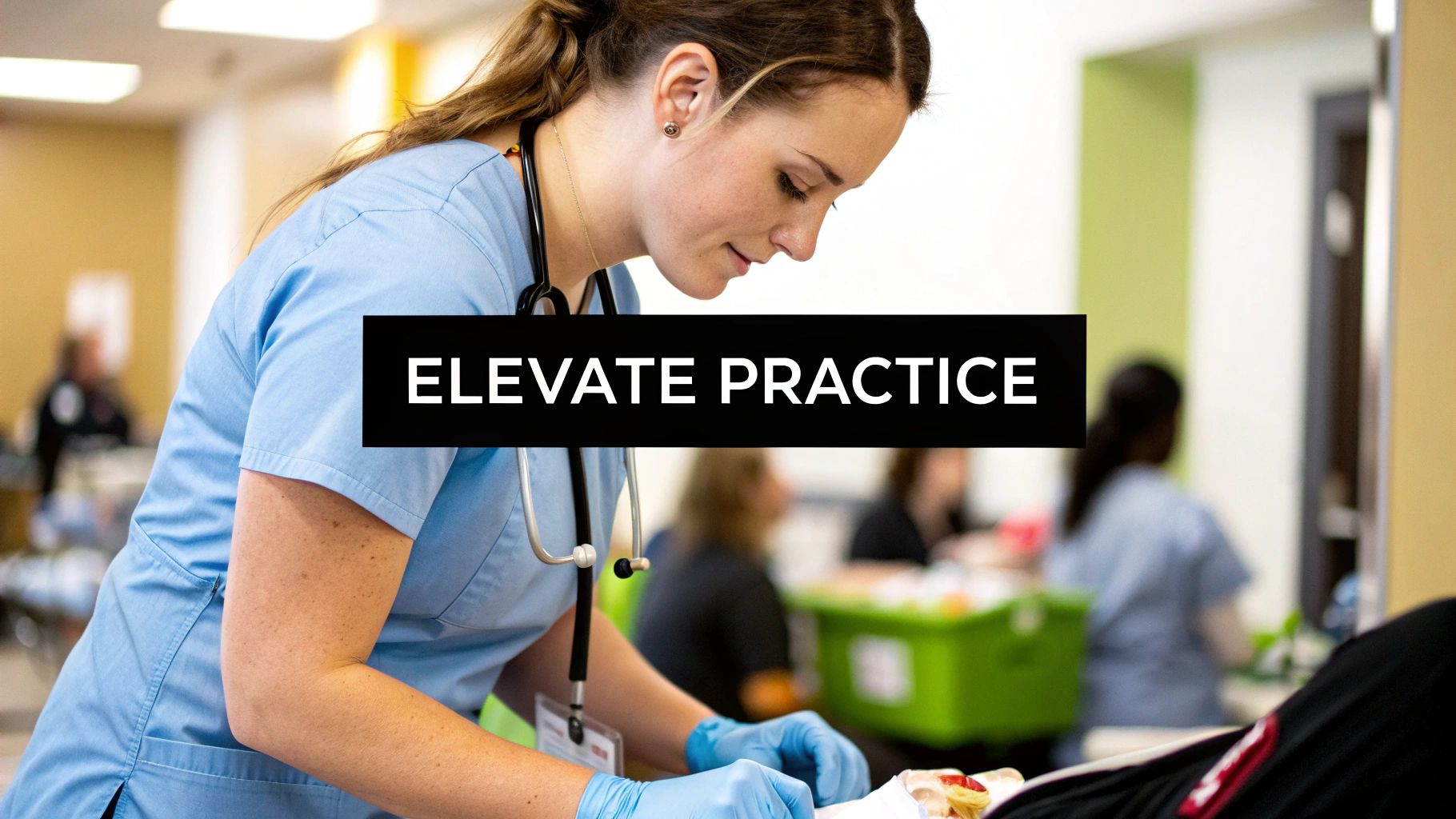Wound care presents a significant hurdle for nurses. Many report feeling ill-equipped to handle the complexities of wound management, even after completing their formal education. This creates a worrying reality gap between the training nurses receive and the actual demands of wound care.
This gap affects not only the nurses but, more importantly, their patients. Providing optimal care becomes a challenge when a nurse’s educational foundation is insufficient. How can we expect positive patient outcomes under these circumstances?
One key factor contributing to this problem is the disconnect between nursing school curricula and the realities of clinical practice. Many programs emphasize theory over practical experience, offering limited hands-on opportunities with diverse wound types.
Furthermore, the rapid pace of advancements in wound care technology and treatment often surpasses curriculum updates. This leaves new graduates unfamiliar with the latest best practices. As a result, nurses enter the workforce lacking the necessary skills to effectively assess, manage, and treat complex wounds.
Bridging the Educational Divide
Another challenge lies in applying evidence-based practice (EBP). While nurses understand the importance of EBP, translating research into practice can be difficult. Factors such as limited awareness of local protocols and insufficient formal education in wound care play a role.
Studies show that up to 71.4% of nurses report inadequate formal wound care education, hindering effective wound management. Learn more about this issue. This isn’t a localized problem; it’s a global concern affecting both primary and acute care settings. This underscores the urgent need for comprehensive wound care training for nurses.
Improving wound care education requires a comprehensive strategy. Nursing schools should prioritize hands-on training and incorporate realistic simulation scenarios. This will better prepare students for the diverse challenges of wound care in real-world clinical settings.
Continuing education is also essential. Practicing nurses need access to ongoing learning opportunities focused on the latest advancements in wound care to maintain and expand their skills. Hospitals and healthcare systems share a responsibility in providing these resources.
Investing in ongoing training and mentorship programs is crucial. By providing these resources, healthcare organizations can empower nurses to deliver high-quality wound care, ultimately leading to improved patient outcomes.
Building Blocks of Exceptional Wound Care Training

Exceptional wound care requires more than just bandages. It involves a complex combination of knowledge, skill, and critical thinking. This necessitates high-quality training that delves deeper than the basics. Effective wound care training programs for nurses are built upon several key components.
Foundational Knowledge: Tissue Types and Wound Science
Understanding different tissue types is crucial. Recognizing healthy granulation tissue versus necrotic tissue, for instance, directly impacts treatment choices. This foundational knowledge forms the basis of wound assessment and management.
Nurses also need a firm grasp of the science behind how wounds heal. This includes understanding the physiological processes of inflammation, proliferation, and remodeling. These processes are essential for effective wound care.
Practical Wound Assessment Frameworks
A solid theoretical understanding must be paired with practical assessment skills. Nurses require frameworks that enable quick and accurate wound evaluation in busy clinical settings.
These frameworks should incorporate standardized measurement techniques and a systematic approach to documenting wound characteristics. Accurate measurements are vital for tracking healing progress and making necessary adjustments to treatment plans.
Hands-On Skills Development: From Measurement to Debridement
Wound care training should include substantial hands-on practice. This involves mastering precise measurement techniques, understanding various debridement methods, and choosing the right dressings.
For example, autolytic debridement differs significantly from sharp debridement in terms of required skills and materials. Practical experience builds confidence and competence in these essential skills, ensuring nurses can effectively apply their knowledge in clinical practice.
Integrating Essential Elements: Pain, Infection, and Patient Education
Exceptional wound care addresses the whole patient. This includes effective pain management, infection prevention and control, and patient education.
Pain management is crucial, as uncontrolled pain can impede healing. Infection control is paramount, as infections can seriously complicate wound healing. Educating patients about proper home wound care promotes self-management and reduces complication risks.
These interconnected elements are integral to comprehensive wound care training. Challenges in the global wound care landscape, such as inconsistent training and the increasing prevalence of chronic wounds, highlight the need for standardized, accessible education. You can learn more about wound care education initiatives at WTA Your Way Wound Care Education. Ultimately, comprehensive training empowers nurses to provide truly patient-centered care.
To further illustrate the key components of a robust wound care training program, the following table provides a detailed overview:
Essential Components of Wound Care Training Programs
A comprehensive overview of the critical elements that should be included in wound care education for nurses
| Training Component | Knowledge/Skills Covered | Clinical Relevance |
|---|---|---|
| Foundational Knowledge | Tissue types, wound healing physiology (inflammation, proliferation, remodeling) | Forms the basis for accurate assessment and treatment planning. |
| Practical Wound Assessment | Standardized measurement techniques, systematic documentation of wound characteristics | Enables efficient and accurate wound evaluation in clinical settings. |
| Hands-on Skills Development | Debridement methods (autolytic, sharp, etc.), dressing selection and application, precise measurement | Translates theoretical knowledge into practical skills, building confidence and competence. |
| Integrating Essential Elements | Pain management techniques, infection prevention and control protocols, patient education strategies | Addresses the holistic needs of the patient, promoting self-management and reducing complications. |
This table highlights the crucial link between theoretical knowledge, practical skills, and patient-centered care in wound management. By covering these core components, training programs equip nurses to provide comprehensive and effective wound care.
Navigating the Certification Maze With Confidence

So, you’re ready to enhance your wound care skills? Choosing the right certification can be a daunting task. This section simplifies the process, guiding you toward credentials that will truly benefit your career.
Understanding the Value of Certification
Why become certified in wound care? Certification validates your expertise and shows your dedication to advanced practice. Many employers prioritize certified nurses for specialized roles. This recognition can lead to new opportunities and career advancement.
Additionally, certification often results in better patient care. Certified nurses have a deeper understanding and enhanced skills, leading to improved patient outcomes. This directly affects patient well-being and satisfaction.
Wound care training and certifications are a growing trend. In 2023, over 8,000 nurses became certified or recertified, highlighting the value of specialized training. This investment in advanced training often improves quality of care and reduces costs. Find more detailed statistics here.
Exploring Key Certification Bodies
Several organizations offer wound care certifications for nurses. Understanding the differences is crucial for selecting the right path. Two leading organizations are the Wound, Ostomy and Continence Nursing Certification Board (WOCNCB) and the National Alliance of Wound Care and Ostomy (NAWCO). Each offers distinct credentials with specific requirements.
To further build your wound care expertise, consider supplemental training through online nursing certifications. These online resources can offer additional knowledge and skill development.
The following table provides a comparison of different wound care certification options. It summarizes key information about each credential, including prerequisites, exam format, and costs.
Comparison of Wound Care Certification Options for Nurses
| Certification Organization | Credential | Prerequisites | Exam Format | Renewal Requirements | Average Cost |
|---|---|---|---|---|---|
| Wound, Ostomy and Continence Nursing Certification Board (WOCNCB) | CWOCN | RN license, specific clinical experience in wound, ostomy, and continence care | Multiple-choice exam | Continuing education and practice hours | $500 |
| National Alliance of Wound Care and Ostomy (NAWCO) | CWS | RN license, specific clinical experience in wound care | Multiple-choice exam | Continuing education and practice hours | $400 |
| American Board of Wound Management (ABWM) | CWCA | Varies depending on specific certification | Multiple-choice exam | Continuing education and practice hours | $400 |
This table provides a quick overview of various wound care certification pathways. Be sure to research each option thoroughly to determine the best fit for your career goals.
Preparing for Certification: Strategies for Busy Nurses
Preparing for certification takes time and effort. However, smart strategies can make the process manageable.
- Create a Study Schedule: Divide the material into smaller sections. Consistent study habits are better than last-minute cramming.
- Utilize Practice Exams: Get familiar with the exam format and identify areas for improvement.
- Join Study Groups: Network with other nurses preparing for certification. Sharing resources and discussing challenging topics can help improve understanding.
Weighing the Investment: Time, Money, and Benefits
Getting certified requires an investment of time, money, and energy. However, the professional rewards often outweigh the costs. Many employers understand the value of certification and may offer to cover or reimburse expenses.
The increased earning potential and career opportunities that come with certification can significantly benefit your long-term financial well-being. This investment in your professional growth can pay off throughout your career.
Transforming Knowledge into Clinical Excellence

Understanding the principles of wound care is essential for nurses. However, putting that knowledge into practice in real-world clinical settings can be challenging. This section explores the important link between theoretical knowledge and practical skills in wound care. We’ll examine proven methods for implementing evidence-based training in various environments, from the busy emergency room to the specific needs of home healthcare.
Bridging the Gap Between Theory and Practice
Effective wound care goes beyond simply memorizing facts. It’s about translating that information into skilled actions at the patient’s bedside. This requires a shift from passive learning to active application.
For instance, while knowing the stages of wound healing is important, the ability to accurately assess a wound and adjust treatment accordingly is what truly makes a difference. One effective approach is using case studies.
Analyzing real-world scenarios helps nurses connect theory to practice. By examining how experienced nurses handle complex cases, newer nurses can develop critical thinking skills and valuable problem-solving techniques. This allows them to learn from the successes and challenges of others, accelerating their professional growth.
Adapting to Individual Patient Needs
Every wound, and every patient, is unique. Wound care training must emphasize individualized treatment plans. Factors such as existing medical conditions, lifestyle, and emotional well-being can all affect healing. This highlights the importance of holistic care, considering the entire person, not just the wound.
Take, for example, a patient with diabetes who develops a foot ulcer. Managing their blood sugar is just as crucial as the topical wound care. This demonstrates the need for a multi-faceted approach, addressing the underlying causes and individual circumstances.
The Power of Mentorship and Hands-On Practice
Mentorship programs are essential for developing skilled wound care nurses. Experienced nurses can guide newer colleagues, offering practical advice, sharing insights, and providing support during difficult situations. This practical guidance is invaluable in building confidence and competence.
Likewise, hands-on practice is essential. Repeatedly practicing skills like wound dressing changes and debridement builds the muscle memory needed for efficient and effective care. This ensures nurses can apply techniques with precision and speed when it matters most.
Utilizing Simulation Training
Simulation training provides a safe environment for nurses to learn and refine essential skills before working with real patients. This allows them to make mistakes and learn from them without risking patient safety.
This approach is particularly helpful for practicing complex procedures like applying negative pressure wound therapy. This risk-free learning environment builds confidence and improves clinical judgment.
Interprofessional Collaboration: A Key to Success
Effective wound care is rarely a solo effort. It requires interprofessional collaboration. Nurses, physicians, physical therapists, and other healthcare professionals working together can achieve better patient outcomes than any single discipline alone.
This collaborative approach utilizes the expertise of each discipline, creating a synergistic treatment plan that benefits the patient. For example, a dietitian can provide vital insights to optimize nutrition for wound healing, while a physical therapist can assist with mobility and pain management. This integrated approach addresses all aspects of patient care, leading to improved outcomes.
Digital Revolution in Wound Care Education
Technology is transforming the way nurses learn about wound care, making quality education more readily available. This offers significant opportunities to enhance skills and elevate patient care. Nurses can now stay current with the latest advancements more easily.
Virtual Reality and Simulation Training
Virtual Reality (VR) simulators provide a safe environment for practicing complex wound care procedures. This risk-free approach allows nurses to develop muscle memory and refine techniques without any potential harm to patients. This is particularly helpful for procedures like debridement, where precision and control are crucial. The result is increased confidence and competence in real-world scenarios.
Mobile Applications for Point-of-Care Guidance
Mobile apps play a growing role in wound care training. These apps provide instant access to valuable information, guiding nurses in wound assessment and dressing selection. This easily accessible resource supports better decision-making at the point of care, ensuring nurses have the most current information readily available. Ultimately, this leads to more informed decisions and improved patient outcomes.
Online Platforms Democratizing Specialized Training
Online learning platforms are expanding access to specialized wound care training. These platforms offer flexible learning options, accommodating busy schedules and varied learning styles. Self-paced modules and interactive exercises allow nurses to learn at their own speed and convenience. This flexibility empowers nurses to pursue continuing education without compromising their work-life balance.
Telehealth Training for Remote Wound Consultation
With the growth of telehealth, remote wound consultation is becoming increasingly common. As a result, wound care training now includes telehealth competencies. Nurses learn to remotely assess wounds, provide guidance, and monitor healing progress using technology. This valuable skill set expands access to care and improves efficiency in wound management, allowing nurses to provide specialized care to patients in remote locations or those with limited mobility. This ultimately enhances the reach and impact of wound care services.
Creating a Culture of Wound Care Excellence
For nurse leaders and educators, effective wound care training is crucial for both positive patient outcomes and staff satisfaction. This section offers a practical guide to developing and implementing successful wound care training programs that truly make a difference. We’ll examine real-world examples of healthcare systems that have improved their wound care practices, revealing effective strategies.
Assessing Needs and Building a Curriculum
The first step is conducting a thorough needs assessment. This identifies existing knowledge gaps and training priorities specific to your team. Are your nurses struggling with the latest dressing technologies? Are they having difficulty recognizing the signs of infection? This targeted approach ensures the training addresses the most pressing needs.
Next, develop a curriculum that engages different learning styles. Incorporate interactive elements, case studies, and hands-on practice to cater to various learners. Think beyond lectures. Consider simulation training or online modules.
Implementing Training Within Operational Realities
Training must fit within the constraints of a busy healthcare setting. Consider offering flexible scheduling, bite-sized learning modules, and online resources to make training accessible. This allows nurses to fit training into their schedules, minimizing disruptions to patient care.
Measuring Competency Beyond Checklists
Effective competency assessment goes beyond simple checklists. Use a variety of methods including observation, simulation scenarios, and patient outcome data to get a complete picture of skill development. For example, observing a nurse perform a dressing change provides more valuable information than simply having them describe the steps. This multi-faceted approach provides a more accurate assessment of nurse competency.
Sustaining Knowledge After Initial Training
Sustaining knowledge requires ongoing effort. Implement regular refreshers, provide access to updated resources, and create a culture of continuous learning. This includes encouraging nurses to attend conferences, participate in online forums, and share best practices with their colleagues. This fosters a dynamic environment where learning becomes an integral part of daily practice.
Creating Wound Care Champions
Identify and develop wound care champions within your team. These nurses become mentors and resources for their colleagues, fostering a culture of excellence. They can lead training sessions, share best practices, and provide bedside support, creating a self-sustaining system of learning.
This peer-to-peer support builds confidence and encourages ongoing skill development, ultimately elevating the quality of wound care throughout your organization. This collaborative approach strengthens the entire team and promotes a sense of shared responsibility for patient care. Dedicated champions can inspire and empower other nurses to embrace best practices in wound care. By fostering this collaborative and supportive environment, you are not just training nurses; you are building a future of exceptional wound care.
Staying at the Edge of Wound Care Practice
In the dynamic field of wound care, continuous learning is crucial for nurses. Staying informed about the latest research and techniques allows nurses to provide the best possible patient care. This section offers guidance on staying ahead in wound care through dependable resources and professional development.
Building Your Professional Learning Network
A proactive approach is key to staying informed. Building a strong professional network connects you with valuable resources and expert insights. Consider joining professional organizations like the Wound, Ostomy and Continence Nurses Society (WOCN). WOCN offers access to educational materials, conferences, and networking opportunities.
Subscribing to reputable wound care journals keeps you updated on the newest research and evidence-based practices. Attending conferences and workshops provides chances to learn from experts, explore new products, and discuss current challenges in wound care. Accessing wound care expertise is vital; learn more about knowledge management in healthcare through this helpful article: Knowledge Management in Healthcare.
Evaluating Educational Resources
With so much information readily available, filtering for quality is essential. Not all resources are created equal. When evaluating a resource, consider the author’s credentials, the publication date, and the source’s reputation. Prioritize evidence-based content supported by research and peer review.
For instance, a recent article in a respected peer-reviewed journal carries more weight than a blog post with an unknown author. Choose your resources carefully to ensure your knowledge is built on a solid foundation of reliable information.
Implementing New Knowledge Systematically
Learning is most valuable when it translates to improved practice. Create a system for integrating new information into your daily routine. This could involve sharing key takeaways from a recent article with your team or trying a new dressing technique with a suitable patient.
Regularly applying new knowledge reinforces learning and helps translate theory into better clinical outcomes. Documenting the results of these changes contributes to further learning and refines your wound care practices. This creates a continuous improvement cycle, benefiting both you and your patients.
The Importance of Ongoing Learning in Wound Care
Wound care is a constantly evolving field. New research, technologies, and treatments are continuously emerging. Lifelong learning is essential for maintaining competence and delivering optimal patient care. This dedication ensures your wound care practice stays evidence-based and current. Prioritizing continuous learning benefits your professional development and positively impacts the lives of your patients.
Ready to enhance your wound care practice? Rapid Wound Care provides comprehensive, at-home wound care services for chronic wounds, pressure injuries, and other complex conditions. Learn more at Rapid Wound Care.

